Napoleon has humbugged me, by God!” Lord Wellington swore. “He has gained twenty-four hours’ march on me!” 1)David Chandler, Waterloo: The Hundred Days, Macmillan Publishing Co., Inc. New York 1980, p. 85 And, indeed, he had.
The Armée du Nord, racing north on the roadnet from Paris to Brussels, now occupied the crucial strategic ‘central position’ between the Anglo-Allied army under Wellington assembling at Quatre Bras in the west, and the Prussian army under Blücher at Ligny in the east. Napoleon, outnumbered by the combined forces of Wellington and Blücher only had one realistic option: destroy his opponent’s armies separately before they could combine and destroy him.
Napoleon divided the Armée du Nord into two wings (the left commanded by Marshal Ney and the right by the Emperor, himself). The Imperial Guard would serve as the strategic reserve. In our previous blog, we showed the MATE (Machine Analysis of Tactical Environments) artificial intelligence analysis of the battle of Ligny.
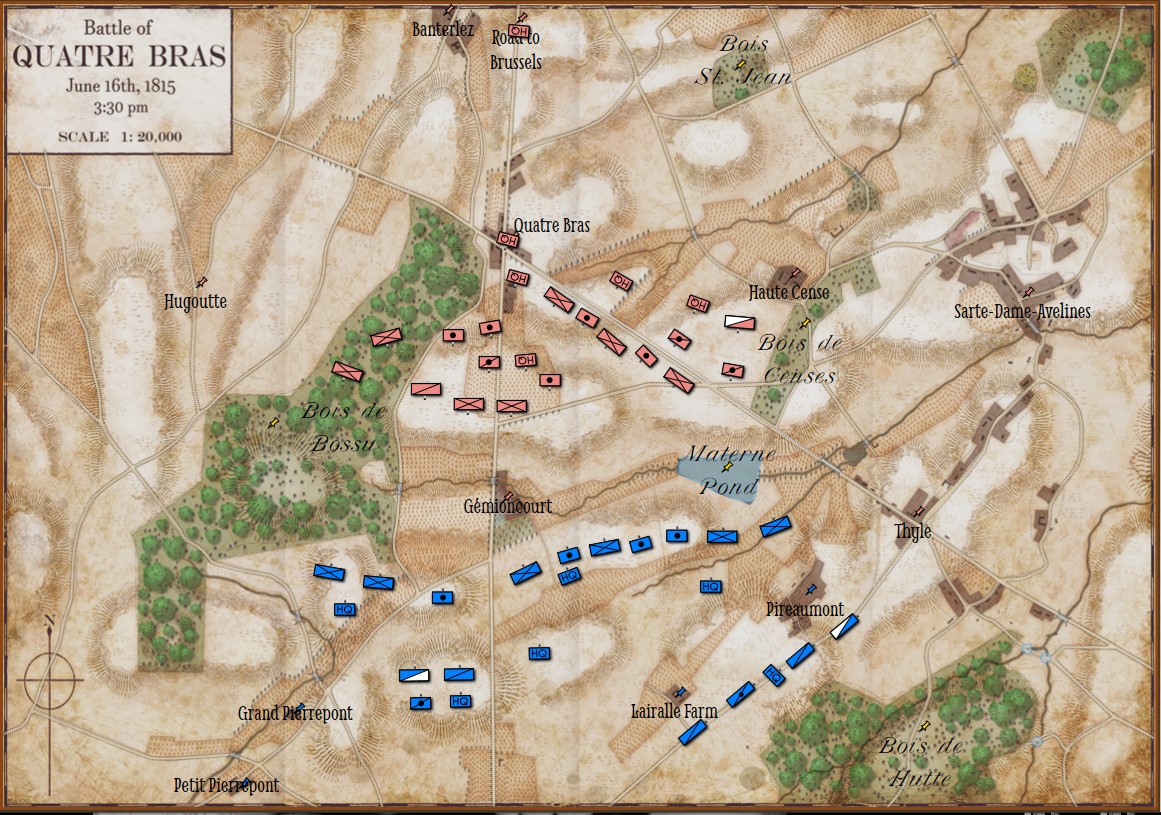
The starting positions of the Armée du Nord (Blue) and the Anglo-Allied Army (Red) at the battle of Quatre Bras. Screen shot from General Staff: Black Powder. Click to enlarge.
The positions in the above screen shot come from the West Point Atlas of the Napoleonic Wars and Chandler’s Waterloo: The Hundred Days. I’ve ordered Mike Robinson’s The Battle of Quatre Bras, 1815 (which is very highly regarded) but it’s coming from Europe and will be a while before it arrives. I’ll update the positions accordingly when it arrives.
Today MATE is going to show off a new trick that it learned.
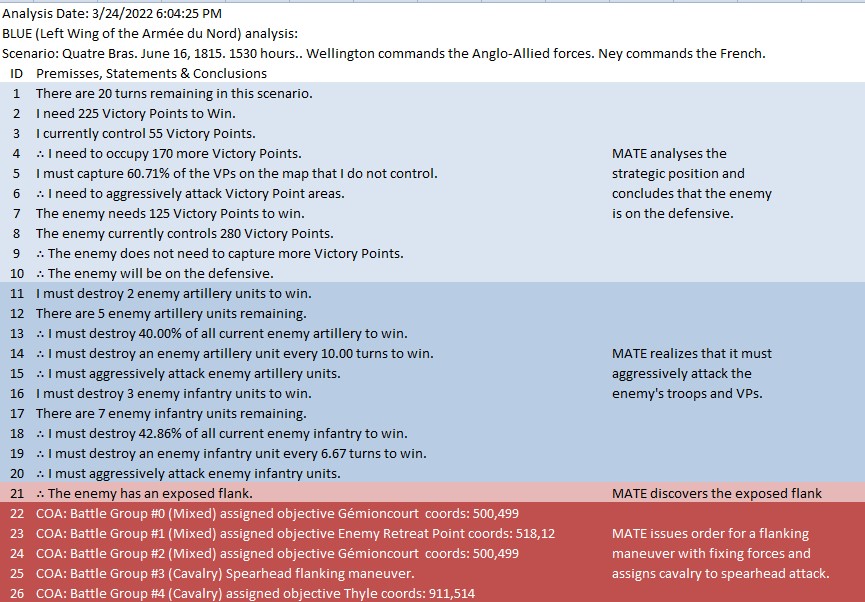
Text output and author’s commentary of MATE’s analysis of Blue’s position at the battle of Quatre Bras.
The salient points of MATE’s analysis of Blue (Ney’s) position at the battle of Quatre Bras are:
- Red (Wellington) has an open flank (in fact, both of Red’s flanks are exposed but MATE has calculated a left flanking maneuver is shorter than a right flanking maneuver)
- Blue has a reserve cavalry division (Line #25 in the text output above, Battle Group #3, Pire’s 2nd Cavalry Division) that is in position to spearhead the left flanking maneuver ahead of
- Battle Group #1 (the 6th Division commanded by Prince Jerome) which will follow as the main strike force of the left flanking maneuver (Line #23)
- Battle Groups #0 and #2 (Reilles and Foy’s divisions) will be the fixing force attacking Gémioncourt in the classic envelopment maneuver (see below):
- Battle Group #4 (Kellerman’s reserve cavalry division) will snatch the important crossroads at Thyle.
In other words, Battle Groups #3 and #1 will be the Enveloping Force and Battle Groups #0 and #2 will be the Fixing Force as illustrated in the above graphic from the U. S. Army Field Manual 3-21. Algorithms for implementing this maneuver (an early version of MATE) first appear in my paper, Implementing the Five Canonical Offensive Maneuvers in a CGF Environment.
And MATE’s new trick? It’s in line #25, above. If there is a Battle Group that is composed entirely of cavalry and horse artillery, and it is close enough, it will be used as the spearhead for the flanking maneuver.
But, in this situation (Ligny, above) MATE has calculated that Battle Group #1 will get to the crucial Choke Point (labeled in black, above) before the reserve cavalry Battle Group #4 will arrive and would create a tremendous bottleneck at the very choke point that MATE wants to quickly capture. Consequently, the cavalry has been left in reserve.
Mini MATE FAQ
Can MATE read and analyze any battle map from history?
No. MATE is integrated into the General Staff Wargaming System. MATE can only ‘understand’ Order of Battle (OOB) tables created in the General Staff Army Editor, maps created in the General Staff Map Editor and scenarios created in the General Staff Scenario Editor.
What is meant by a ‘human-level’ artificial intelligence?
Perhaps you have heard of the famous Turing Test (from Alan Turing’s Computing Machinery and Intelligence). In it he describes, “The Imitation Game,” where a computer is in one room behind a closed door, and a human is another room behind a closed door. A third person, the ‘interrogator’, can only ask questions via a teletype (an ancient I/O device consisting of a keyboard and a printer) and must determine in which room the computer is and in which room is the human. In Turing’s original paper the interrogator would ask questions of the two subjects such as, “Please write me a sonnet on the subject of the Forth Bridge,” and, “Add 34957 to 70764.” Currently, no Artificial Intelligence (AI) could pass such a test; the subject area is far too broad. However, it has been my thesis, that an AI could pass such a test if the subject area is restricted to a narrow field of human endeavor, such as commanding units on a battlefield. If, in the above Turing test, the computer in one room was replaced with MATE, the human in the other room was replaced by Napoleon, and the teletype was replaced by the General Staff Wargaming System, I argue that MATE could (or soon will be able to) pass such a test (subject matter experts would not be able to discern if it was MATE or Napoleon giving orders).
Can MATE analyze current military situations?
Though MATE came out of the TIGER (Tactical Inference GenERator) project funded by DARPA, it is currently set up specifically for the General Staff: Black Powder project which limits analysis to scenarios in the 18th and 19th centuries. It is intended that this project will be followed up with General Staff: Modern Warfare to specifically work with 20th and 21st century combat.
References
| ↑1 | David Chandler, Waterloo: The Hundred Days, Macmillan Publishing Co., Inc. New York 1980, p. 85 |
|---|

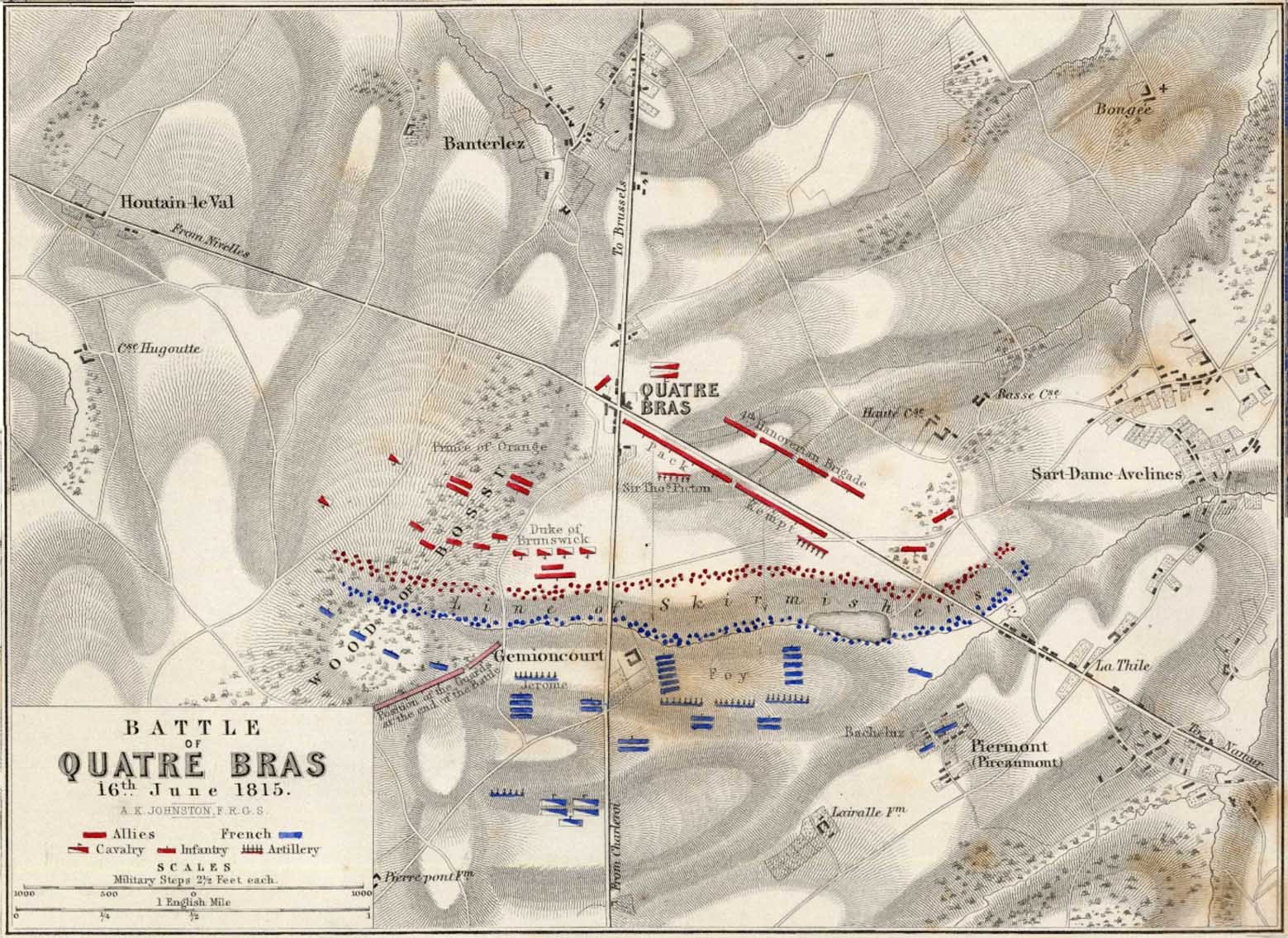

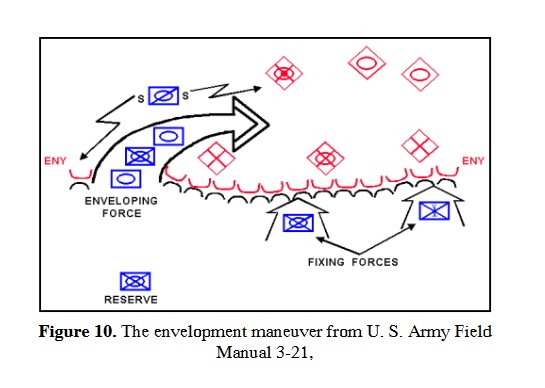
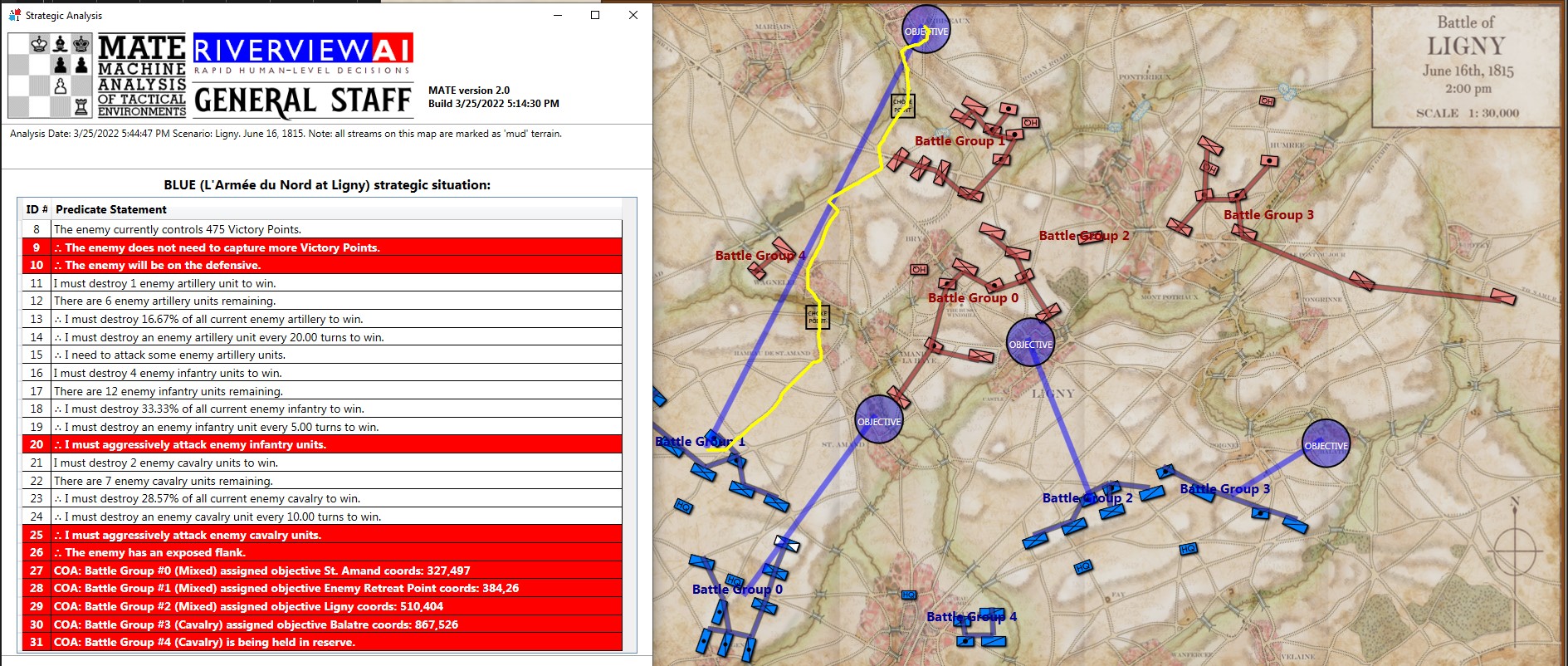
I read over the Human Level Intelligence posts, and it left me scratching my head – although I an natural critique.
I the Real maps has cavalry detachments covering this open flank. (Are such thing possible in the game?)
But regardless I think the idea of going through a forest to take a long route to flank is questionable even if knows the road though and other side are open. A commander would lose contact with that maneuver element, take men out of the battle and split his forces which would open up to being defeated in detail, all for a maneuver that may take to long.
Sounds very interesting – looking forward to seeing it!
One thing I’d be interested in how General Staff progresses the attack. There is an initial plan, but the enemy will respond – they may retreat, they may counterattack. The attack may suffer reverses, objectives may require modification, the attack may even need to be abandoned or turn into a retreat. How does General Staff adjust its position? Needless to say, it couldn’t start with a blank slate each move – there must be continuity, units must be executing a plan. But it also needs to change and adapt.
Regards
Gareth
MATE reevaluates its plans every ‘turn’. A turn is broken up into 10 simultaneous moves.
Thanks, Ezra
Regards
Gareth
There was a problem: Mate chose a route that was completely behind the trees.
I think historically the French might have had some concerns about taking this route. Obstructed vision, unknown intelligence, miscalculations of Wellington’s strength, and so on. Such misjudgments are quite common, as between the both sides of Ligny.
So does Mate now instantly update intelligence based on what it sees in the software – even if it’s a miscalculation?
From the map that I’m working with it’s a legitimate road through the forest.If it’s not a good road, then it shouldn’t be on the map. I’m waiting on a new book from Europe (The Battle of Quatre Bras) that might provide more information. But, MATE can only work with the maps that I give it.
I don’t mean merely that the roads were good or bad. In Ney’s place, for example, he didn’t know how many Wellington’s troops were in the woods, where the line could reach, and whether there were skrimishers nearby. All he knows is that there are probably enemy troops around here. I thought he had good reason not to venture through the woods; after all, cavalry, artillery, and the main line infantry would be useless if there was a battle in the middle of the woods.
So here’s my question: can Mate now make his tactical plans based on a miscalculation of enemy conditions?
Here’s a screen shot of what Blue can see (Fog of War). Okay, it looks like I can’t just paste it in, I have to upload it somewhere and link the URL. Anyway, what it shows is what MATE can see. Can MATE make a bad decision based on hidden enemy positions? Sure. Absolutely.
Thank you for your answer. I’ve read your article about FOW, and I think it’s a pretty good way to process — like Command Ops 2. However, since FOW does not specify how this affects the AI’s decisions, it makes me wonder if the AI is cheating in this area.
But now that things are clear that my fears were unwarranted. General Staff is really quite an amazing achievement and I have been waiting for it for years and I sincerely thank you and your colleagues for your continued work.
Regards
The AI definitely does not cheat and I can prove it (it only sees what we let it). I’ll do a post on it.
I agree with Miquel. I really want to see the video of the actual operation of the game. I look forward to Mr. Ezra meeting our expectations in the next log update.Thank you!
I just purchased a suite of video screen capture and editing software to do this!
That’s great! I can’t wait to watch it. Thank you Ezra!
Are there any gameplay videos or beta AARs we can take a look at? How does General Staff AI handle contingencies as the game/sim plays forward? What if there actually was a brigade on the route selected for the flanking maneuver? How does MATE – in the game not the papers – handle uncertainty in the initial conditions?
Thank you for the posts, always interesting!
If there was a brigade (or even a cavalry unit) on the flanking route, MATE would not use that route. It would either go with the other flank or no flanking maneuver whatsoever.
Great achievement! I’m glad MATE has reached an amazing level. And it’s so malleable and possible. Looking forward to the release of this great game
Thank you so much!